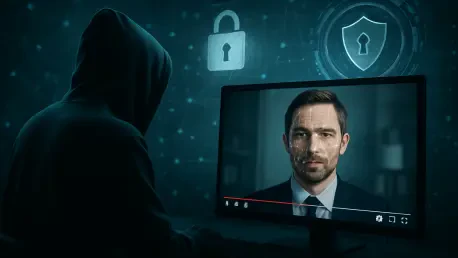In an era where artificial intelligence is reshaping the digital landscape, the rise of deepfake technology has emerged as a formidable challenge for enterprises worldwide, with cybercriminals exploiting synthetic media to deceive and defraud at an unprecedented scale. Reports indicate that a staggering 85% of cybersecurity and IT leaders at mid-range and large organizations have encountered at least one deepfake attack in the past year, marking a significant uptick in these sophisticated threats. The financial toll is equally alarming, with average losses per incident reaching $280,000, and some cases soaring past $1 million. As attackers refine their methods across static images, audio, video, and even live interactions, the gap between the growing menace and corporate readiness to combat it has become a pressing concern. This alarming trend underscores the urgent need for robust strategies to address a technology that is as innovative as it is dangerous, leaving many to question whether businesses can catch up before the damage becomes irreparable.
Rising Incidence and Impact of Deepfake Attacks
Escalating Frequency of Sophisticated Threats
The surge in deepfake incidents over recent months paints a troubling picture for enterprise security, as attackers increasingly leverage AI-driven tools to craft convincing forgeries that bypass traditional defenses. A notable 40% of surveyed organizations reported facing three or more such attacks in the past year, a clear indication of how relentless and pervasive this threat has become. Financial repercussions are severe, with over 61% of affected entities losing at least $100,000 per incident, highlighting the high stakes involved. The methods of attack are also diversifying, with email-based deepfakes and static images each accounting for 59% of cases, while audio manipulations have seen a dramatic rise from a lower base to affecting 52% of reported incidents. This evolution in tactics demonstrates how cybercriminals are adapting to exploit vulnerabilities across multiple formats, making it imperative for organizations to stay ahead of these deceptive strategies that can undermine trust and financial stability in mere moments.
Broadening Attack Vectors and Their Consequences
Beyond the sheer number of deepfake attacks, the broadening range of attack vectors adds another layer of complexity to the challenge faced by enterprises today. Video-based deepfakes and live interactions, though less common than static or email-based methods, are gaining traction as tools for deception, often used to impersonate executives or manipulate stakeholders in real-time scenarios. The financial impact cannot be overstated, as losses in the millions have been recorded by some organizations, eroding not just budgets but also reputations built over years. Audio deepfakes, in particular, have emerged as a fast-growing concern, with their ability to mimic voices with uncanny accuracy, leading to fraudulent transactions or unauthorized access. This diversity in attack methods signals a critical need for comprehensive defense mechanisms that can address the full spectrum of synthetic media threats, rather than focusing on a single point of vulnerability, as the cost of inaction continues to mount across industries.
Gaps in Defense Strategies and Preparedness
Insufficient Investment in Protective Measures
Despite the clear and present danger posed by deepfake technology, a significant lag in defense investment remains a glaring issue for many organizations grappling with how to allocate resources effectively. While security teams are increasingly prioritizing the issue, the actual budget committed to countering these threats falls short of what is needed to keep pace with rapidly evolving AI tools. This hesitation often stems from the nascent state of deepfake defense solutions, as many leaders appear to be waiting for more mature technologies before fully investing, even as financial damages pile up. The disconnect between the recognition of risk and the action taken to mitigate it reflects a broader caution in the market, where the fear of investing in unproven solutions competes with the reality of mounting losses. Until this gap is bridged with decisive funding and strategic planning, enterprises remain exposed to attacks that exploit their indecision with devastating precision.
Challenges in Training and Employee Readiness
Training initiatives aimed at preparing employees to identify and respond to deepfake threats have seen widespread adoption, yet their effectiveness raises serious questions about organizational readiness. Approximately 88% of surveyed enterprises have implemented such programs in the past year, a marked increase from previous efforts, but the average first-try simulation pass rate lingers at a mere 44%. Only a small fraction—8%—achieved pass rates of 80% or higher, revealing a substantial shortfall in equipping staff to handle these sophisticated attacks. This gap in preparedness is particularly concerning given that 94% of respondents expressed worry about deepfakes, with a majority feeling very concerned. Yet, paradoxically, nearly all claim confidence in their defenses, a contradiction that may stem from overoptimism or an underestimation of the threat’s complexity. Addressing this training deficit with more targeted and effective programs is essential to bolster the human element of cybersecurity.
Navigating the Preparedness Paradox
The so-called preparedness paradox further complicates the landscape, as the near-universal concern among IT and cybersecurity leaders fails to translate into proportional action or resource allocation to combat deepfake threats. While 99% of respondents assert confidence in their ability to defend against such attacks, the reality of frequent incidents and significant financial losses tells a different story. This discrepancy could be attributed to a combination of wishful thinking and an overreliance on future technological advancements that have yet to materialize. The rapid evolution of AI-driven synthetic media across audio, video, and live formats only widens this gap, leaving many enterprises vulnerable to substantial damages. Overcoming this paradox requires a shift in mindset, where concern is matched with immediate, actionable strategies rather than deferred solutions, ensuring that recognition of the problem becomes the foundation for tangible and effective countermeasures.
Future Steps for Mitigating Deepfake Risks
Enhancing Training for Comprehensive Coverage
Looking back, the response to the escalating deepfake threat revealed a critical need for enhanced training programs that had to cover the full range of synthetic media sophistication to better prepare employees. Past efforts showed that while many organizations rolled out educational initiatives, the low pass rates in simulations underscored a gap in practical application. Reflecting on those challenges, it became evident that training needed to evolve beyond basic awareness, incorporating real-world scenarios and frequent updates to address emerging tactics used by attackers. By focusing on interactive and adaptive learning models, enterprises could have significantly improved employee readiness to detect and respond to deepfakes, reducing the likelihood of costly breaches. This retrospective highlights how vital it was to prioritize depth and relevance in training to build a resilient human firewall against AI-driven deception.
Adopting Advanced Detection and Response Solutions
In hindsight, adopting advanced detection technologies tailored to keep pace with AI advancements proved to be a cornerstone for mitigating deepfake risks in the past. Solutions that integrated machine learning to identify subtle anomalies in audio, video, and images were essential in countering the increasingly sophisticated forgeries that plagued enterprises. Additionally, developing incident response processes specifically designed for synthetic media threats allowed organizations to act swiftly when breaches occurred, minimizing damage. Reflecting on those times, the importance of continuous innovation in detection tools and response frameworks was clear, as static defenses quickly became obsolete against evolving threats. Moving forward from that point, the focus should remain on investing in scalable technologies and protocols that adapt to new attack vectors, ensuring a proactive stance against the financial and reputational harm caused by deepfakes.









